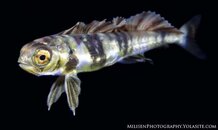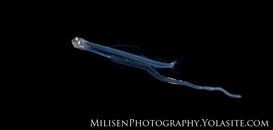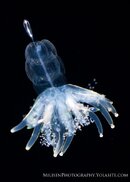You are using an out of date browser. It may not display this or other websites correctly.
You should upgrade or use an alternative browser.
You should upgrade or use an alternative browser.
The pelagic animal game
- Thread starter smellzlikefish
- Start date
Please register or login
Welcome to ScubaBoard, the world's largest scuba diving community. Registration is not required to read the forums, but we encourage you to join. Joining has its benefits and enables you to participate in the discussions.
Benefits of registering include
- Ability to post and comment on topics and discussions.
- A Free photo gallery to share your dive photos with the world.
- You can make this box go away
mahi mahi?
smellzlikefish
Contributor
I want to say a file fish, but probably more like a pompano or jack
smellzlikefish
Contributor
The extruded gut is the key here, present in neither Carangids nor Monocanthids. Keep trying!
Ding ding! Vincent got it! As carapids mature they lose the head filament (known as a vexillum) and long tail filament. Many species live out their adulthood in the anuses of echinoderms. Many even parasitize their hosts' gonads!
Let's try another one. You will probably be familiar with the adult version of this:
View attachment 211146
If anyone is still listening, the last one was a yellow tang larva (Zebrasoma flavescens) somewhere around or after day 40. I am told that the pigment sash over its eye is a form of mimicry that looks like a smaller fish pointing up. Nature is weird.
On a thread on FB, a similar photo was posted and one of the comments was :
that mimicry thing is likely "fake" mimicry, something humans notice that isn't purposeful- usually a fish does NOT want to look like a smaller fish that would attract predators. Note that the silver protects the brain and viscera from UV light, and the opaque cover of the gut prevents luminescence of prey attracting predators. Many larval fishes have black or silver coverings of the cranium and gut, just not stretched out like this.
Interesting... yes, animals are weird.. freaking awesome..
smellzlikefish
Contributor
Interesting concept. Evolution does not have a defined "purpose," but instead just kind of stumbles around until something works and gets passed on to the next generation. The mimicry here was actually pointed out by a couple of larval fish experts at the Smithsonian, but the advantages you point out are certainly valid. I'll send your thoughts along and see how they react.
The most recent post was a larval Astronesthes, or snaggletooth, in the family Stomiidae. As an adult, this animal will live in mesopelagic (midwater) and develop a barbel under its chin that acts as a sort of lure.
The most recent post was a larval Astronesthes, or snaggletooth, in the family Stomiidae. As an adult, this animal will live in mesopelagic (midwater) and develop a barbel under its chin that acts as a sort of lure.
smellzlikefish
Contributor
My first guess would be a giant squid. Or that giant octopus found in the Pacific NW
And that is without hoovering over the image to see the file name and doing a simple google search.
And that is without hoovering over the image to see the file name and doing a simple google search.
smellzlikefish
Contributor
Well that's a rookie mistake on my part! Damn.
Similar threads
- Replies
- 22
- Views
- 2,959
- Replies
- 0
- Views
- 1,214
- Replies
- 0
- Views
- 1,955
- Replies
- 4
- Views
- 869







